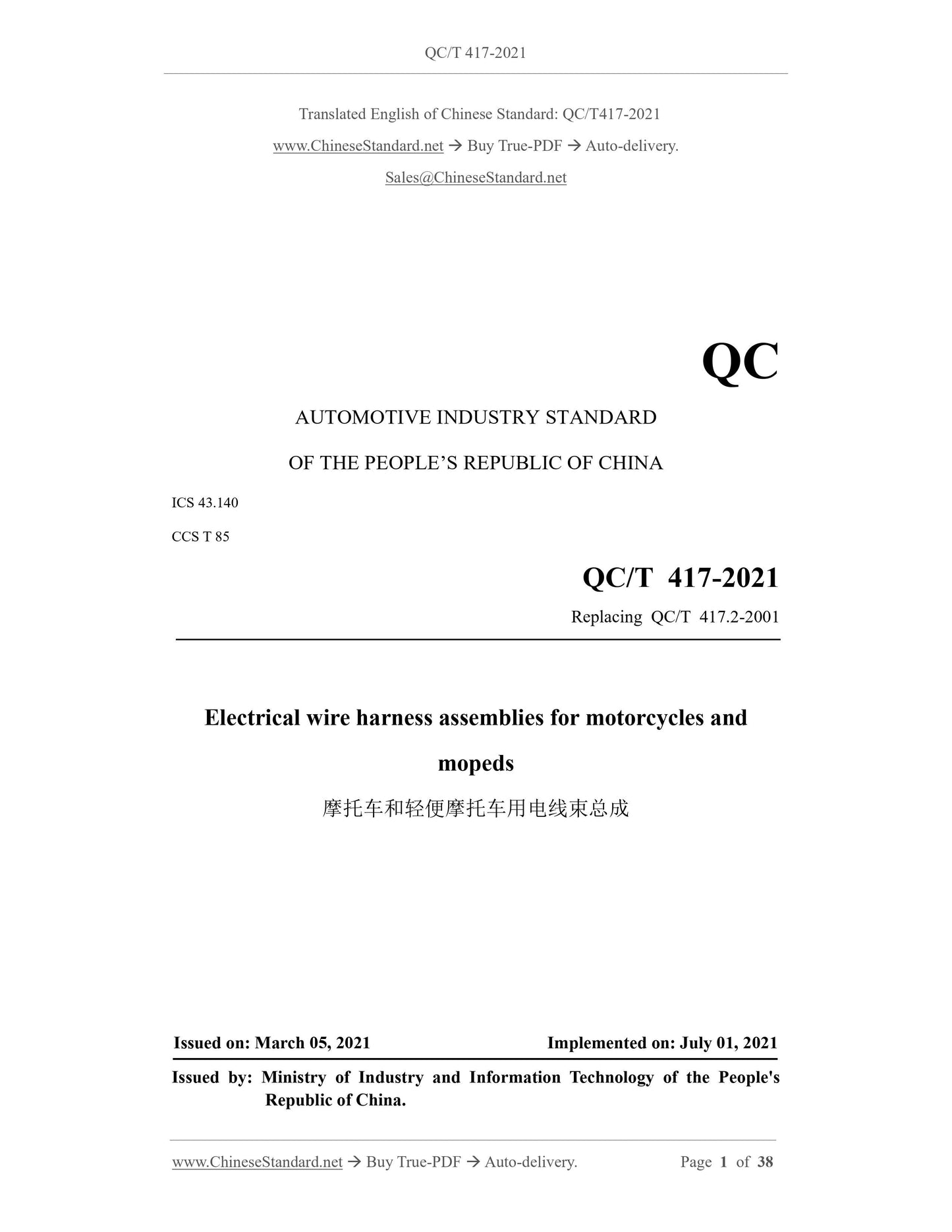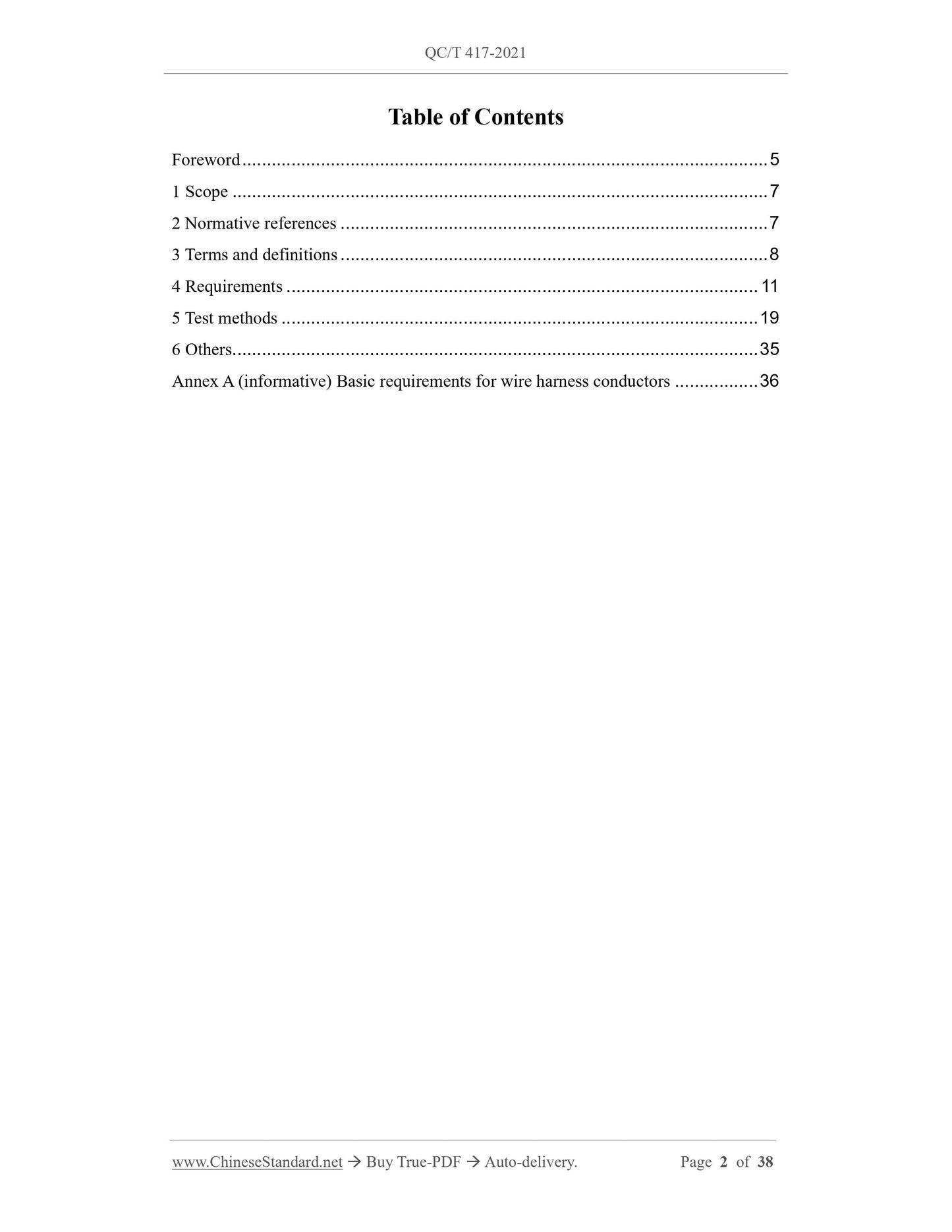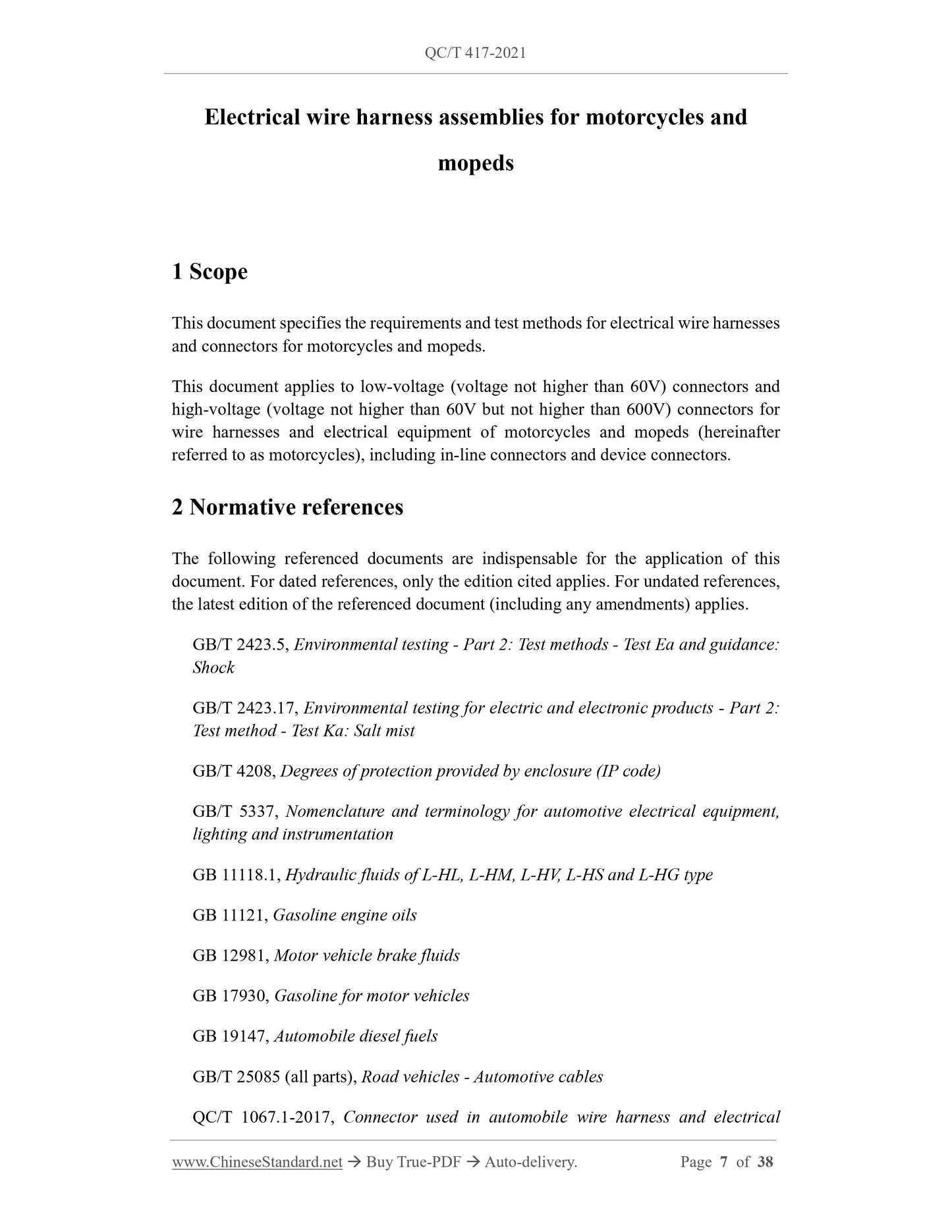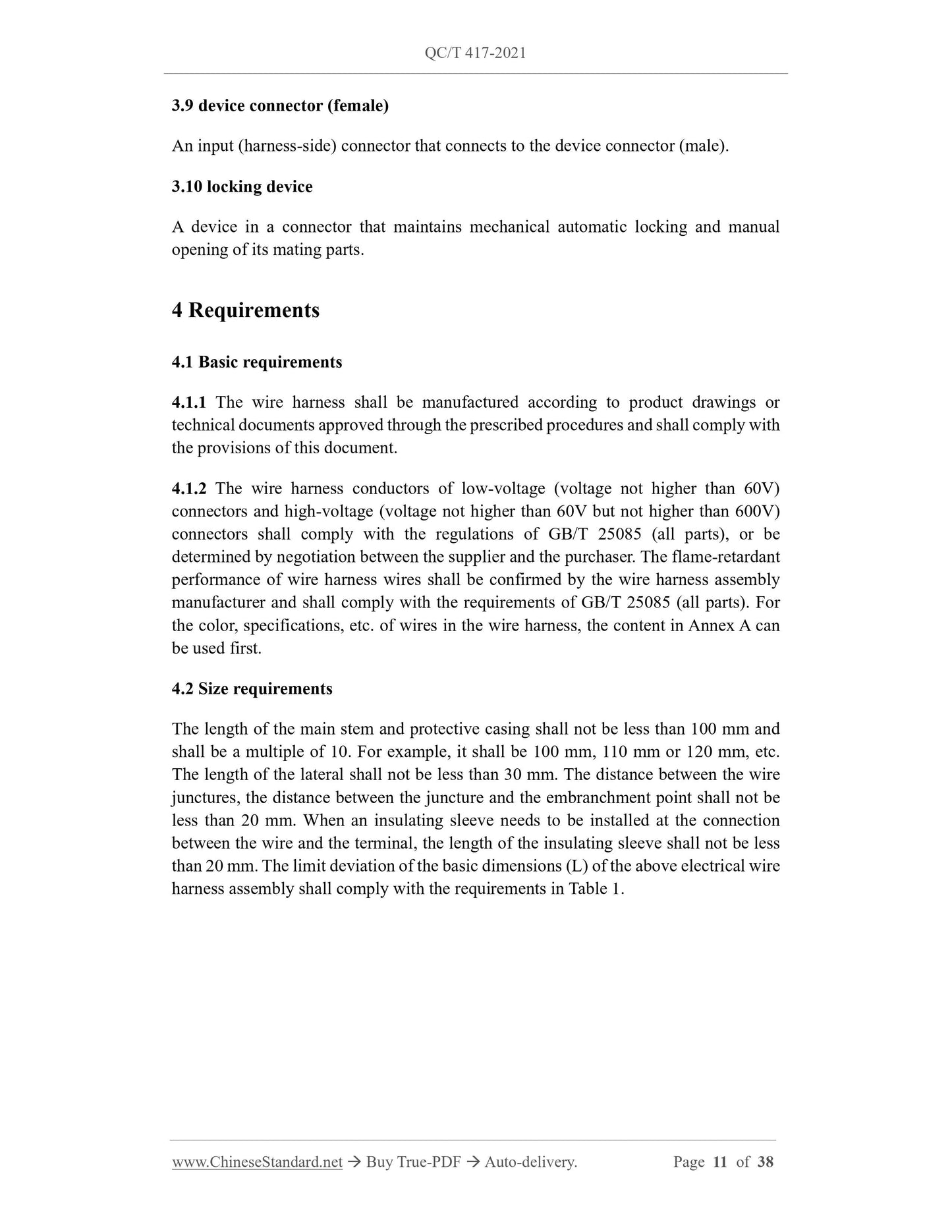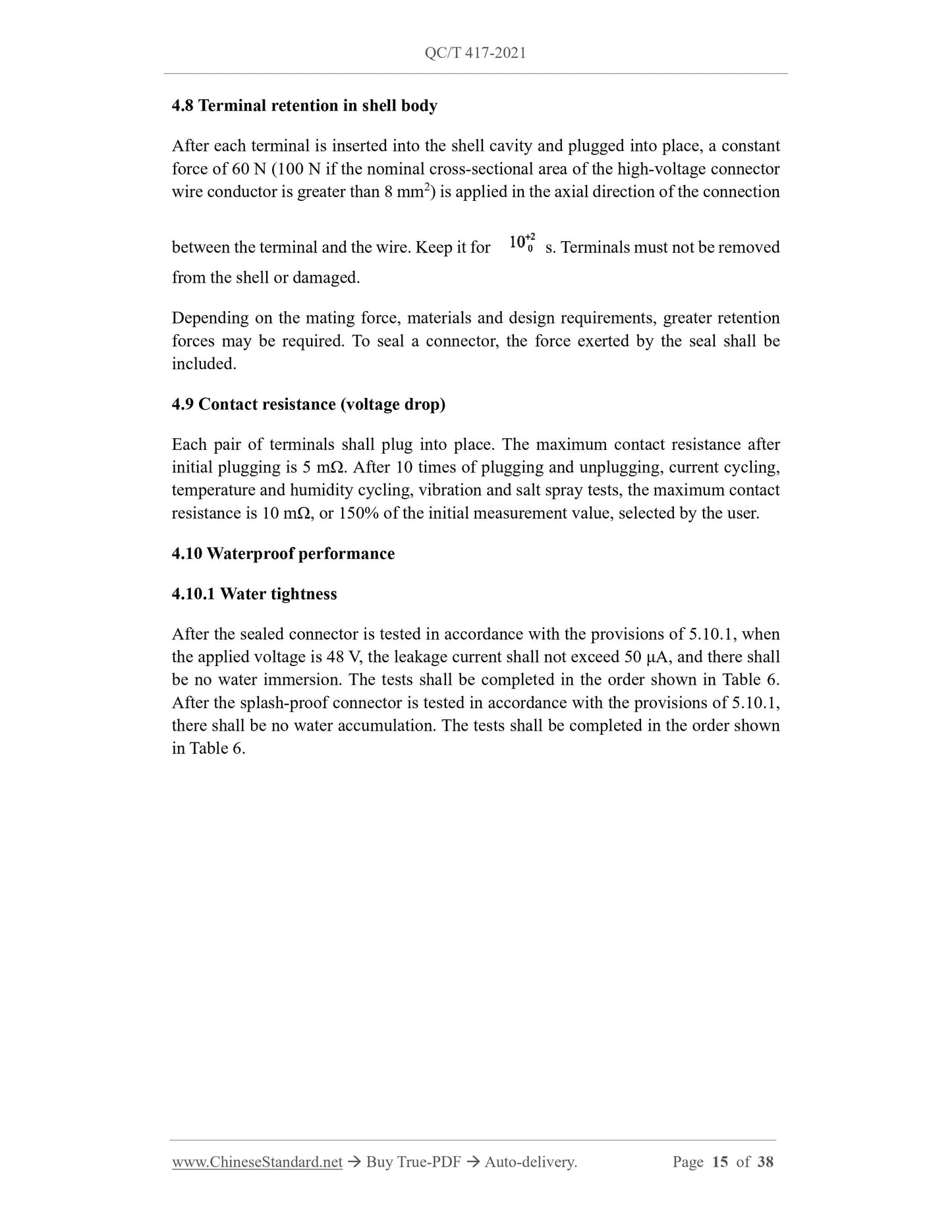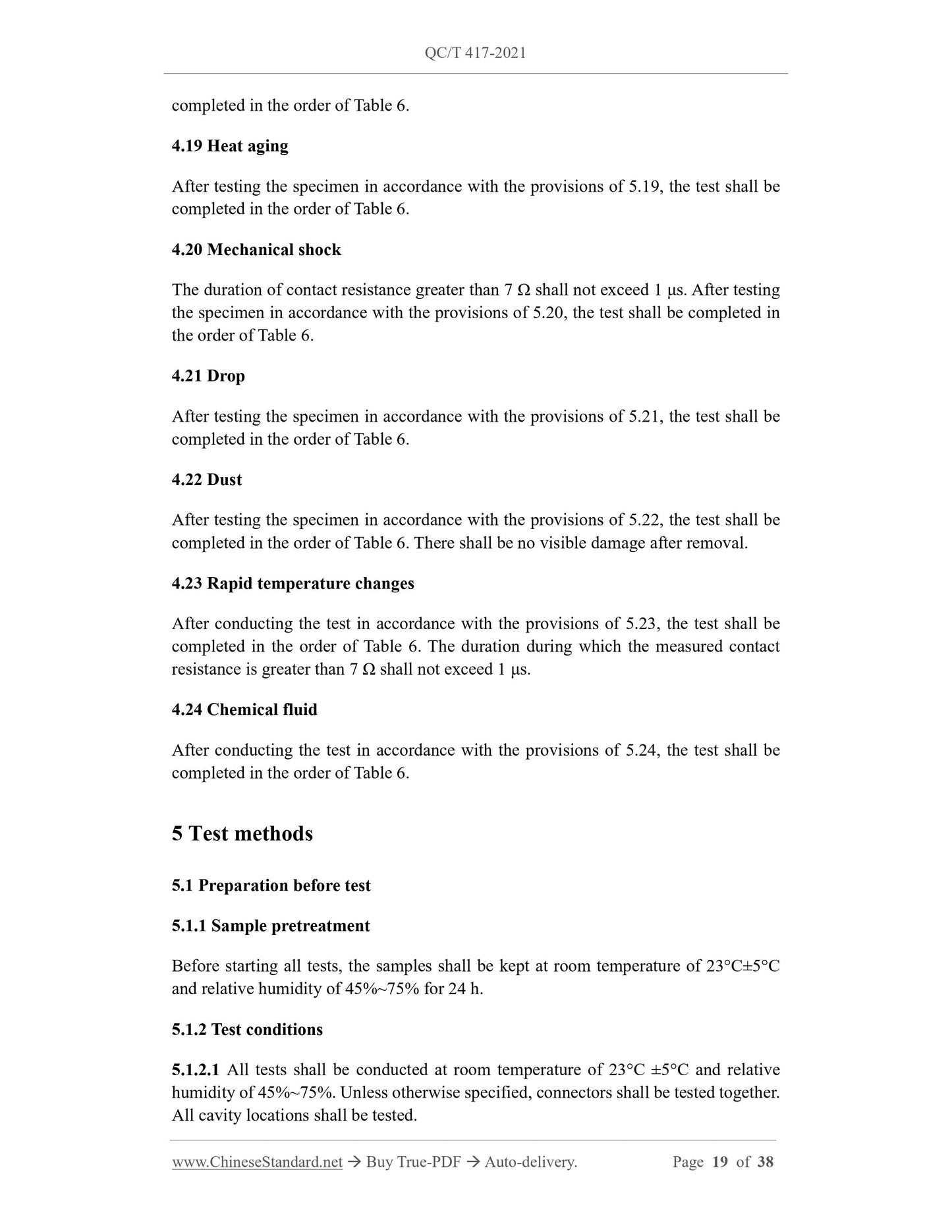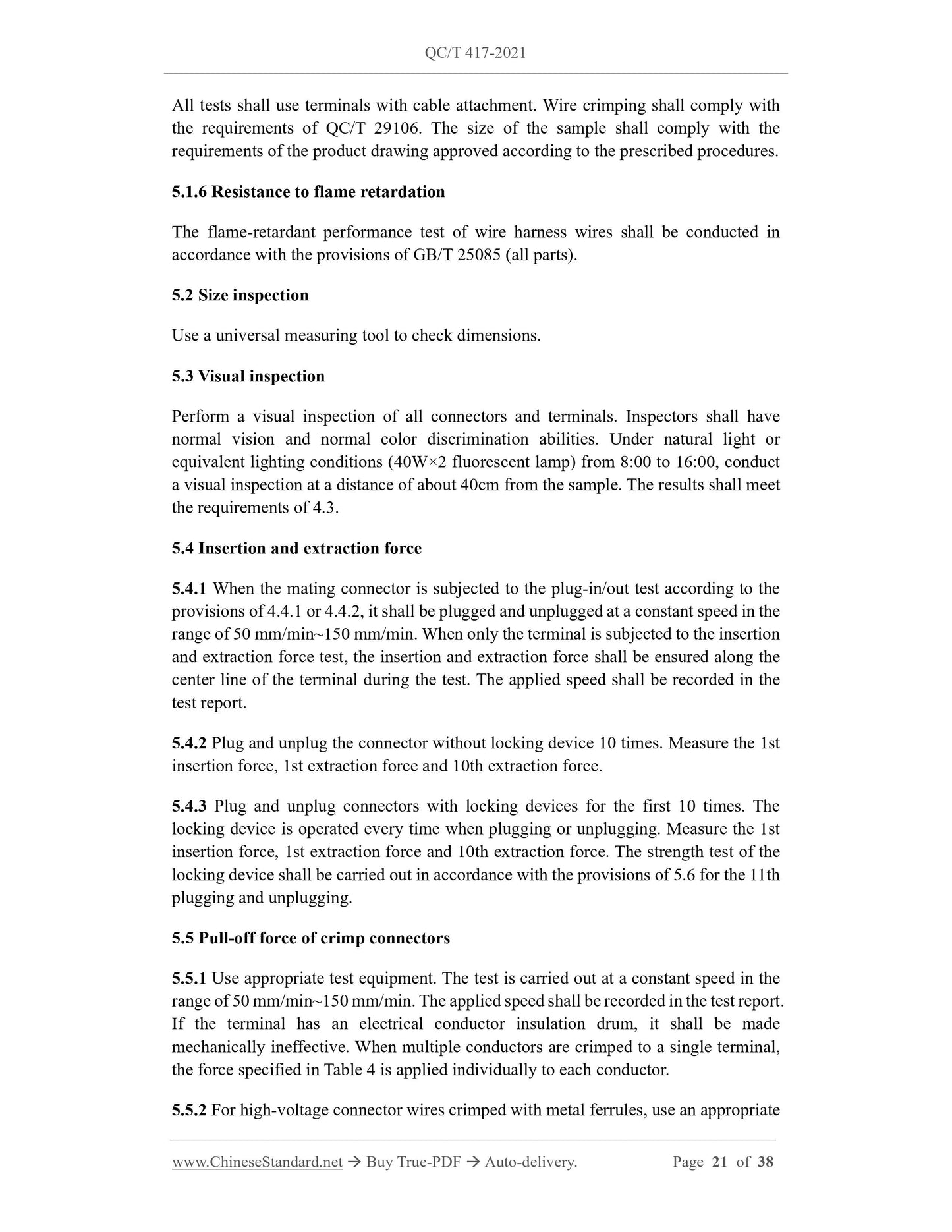1
/
av
7
PayPal, credit cards. Download editable-PDF and invoice in 1 second!
QC/T 417-2021 English PDF (QCT417-2021)
QC/T 417-2021 English PDF (QCT417-2021)
Ordinarie pris
$550.00 USD
Ordinarie pris
Försäljningspris
$550.00 USD
Enhetspris
/
per
Frakt beräknas i kassan.
Det gick inte att ladda hämtningstillgänglighet
Delivery: 3 seconds. Download true-PDF + Invoice.
Get QUOTATION in 1-minute: Click QC/T 417-2021
Historical versions: QC/T 417-2021
Preview True-PDF (Reload/Scroll if blank)
QC/T 417-2021: Electrical wire harness assemblies for motorcycles and mopeds
QC/T 417-2021
QC
AUTOMOTIVE INDUSTRY STANDARD
OF THE PEOPLE’S REPUBLIC OF CHINA
ICS 43.140
CCS T 85
Replacing QC/T 417.2-2001
Electrical wire harness assemblies for motorcycles and
mopeds
ISSUED ON: MARCH 05, 2021
IMPLEMENTED ON: JULY 01, 2021
Issued by: Ministry of Industry and Information Technology of the People's
Republic of China.
Table of Contents
Foreword ... 5
1 Scope ... 7
2 Normative references ... 7
3 Terms and definitions ... 8
4 Requirements ... 11
5 Test methods ... 19
6 Others ... 35
Annex A (informative) Basic requirements for wire harness conductors ... 36
Electrical wire harness assemblies for motorcycles and
mopeds
1 Scope
This document specifies the requirements and test methods for electrical wire harnesses
and connectors for motorcycles and mopeds.
This document applies to low-voltage (voltage not higher than 60V) connectors and
high-voltage (voltage not higher than 60V but not higher than 600V) connectors for
wire harnesses and electrical equipment of motorcycles and mopeds (hereinafter
referred to as motorcycles), including in-line connectors and device connectors.
2 Normative references
The following referenced documents are indispensable for the application of this
document. For dated references, only the edition cited applies. For undated references,
the latest edition of the referenced document (including any amendments) applies.
GB/T 2423.5, Environmental testing - Part 2: Test methods - Test Ea and guidance:
Shock
GB/T 2423.17, Environmental testing for electric and electronic products - Part 2:
Test method - Test Ka: Salt mist
GB/T 4208, Degrees of protection provided by enclosure (IP code)
GB/T 5337, Nomenclature and terminology for automotive electrical equipment,
lighting and instrumentation
GB 11118.1, Hydraulic fluids of L-HL, L-HM, L-HV, L-HS and L-HG type
GB 11121, Gasoline engine oils
GB 12981, Motor vehicle brake fluids
GB 17930, Gasoline for motor vehicles
GB 19147, Automobile diesel fuels
GB/T 25085 (all parts), Road vehicles - Automotive cables
QC/T 1067.1-2017, Connector used in automobile wire harness and electrical
3.9 device connector (female)
An input (harness-side) connector that connects to the device connector (male).
3.10 locking device
A device in a connector that maintains mechanical automatic locking and manual
opening of its mating parts.
4 Requirements
4.1 Basic requirements
4.1.1 The wire harness shall be manufactured according to product drawings or
technical documents approved through the prescribed procedures and shall comply with
the provisions of this document.
4.1.2 The wire harness conductors of low-voltage (voltage not higher than 60V)
connectors and high-voltage (voltage not higher than 60V but not higher than 600V)
connectors shall comply with the regulations of GB/T 25085 (all parts), or be
determined by negotiation between the supplier and the purchaser. The flame-retardant
performance of wire harness wires shall be confirmed by the wire harness assembly
manufacturer and shall comply with the requirements of GB/T 25085 (all parts). For
the color, specifications, etc. of wires in the wire harness, the content in Annex A can
be used first.
4.2 Size requirements
The length of the main stem and protective casing shall not be less than 100 mm and
shall be a multiple of 10. For example, it shall be 100 mm, 110 mm or 120 mm, etc.
The length of the lateral shall not be less than 30 mm. The distance between the wire
junctures, the distance between the juncture and the embranchment point shall not be
less than 20 mm. When an insulating sleeve needs to be installed at the connection
between the wire and the terminal, the length of the insulating sleeve shall not be less
than 20 mm. The limit deviation of the basic dimensions (L) of the above electrical wire
harness assembly shall comply with the requirements in Table 1.
4.8 Terminal retention in shell body
After each terminal is inserted into the shell cavity and plugged into place, a constant
force of 60 N (100 N if the nominal cross-sectional area of the high-voltage connector
wire conductor is greater than 8 mm2) is applied in the axial direction of the connection
between the terminal and the wire. Keep it for s. Terminals must not be removed
from the shell or damaged.
Depending on the mating force, materials and design requirements, greater retention
forces may be required. To seal a connector, the force exerted by the seal shall be
included.
4.9 Contact resistance (voltage drop)
Each pair of terminals shall plug into place. The maximum contact resistance after
initial plugging is 5 mΩ. After 10 times of plugging and unplugging, current cycling,
temperature and humidity cycling, vibration and salt spray tests, the maximum contact
resistance is 10 mΩ, or 150% of the initial measurement value, selected by the user.
4.10 Waterproof performance
4.10.1 Water tightness
After the sealed connector is tested in accordance with the provisions of 5.10.1, when
the applied voltage is 48 V, the leakage current shall not exceed 50 μA, and there shall
be no water immersion. The tests shall be completed in the order shown in Table 6.
After the splash-proof connector is tested in accordance with the provisions of 5.10.1,
there shall be no water accumulation. The tests shall be completed in the order shown
in Table 6.
completed in the order of Table 6.
4.19 Heat aging
After testing the specimen in accordance with the provisions of 5.19, the test shall be
completed in the order of Table 6.
4.20 Mechanical shock
The duration of contact resistance greater than 7 Ω shall not exceed 1 μs. After testing
the specimen in accordance with the provisions of 5.20, the test shall be completed in
the order of Table 6.
4.21 Drop
After testing the specimen in accordance with the provisions of 5.21, the test shall be
completed in the order of Table 6.
4.22 Dust
After testing the specimen in accordance with the provisions of 5.22, the test shall be
completed in the order of Table 6. There shall be no visible damage after removal.
4.23 Rapid temperature changes
After conducting the test in accordance with the provisions of 5.23, the test shall be
completed in the order of Table 6. The duration during which the measured contact
resistance is greater than 7 Ω shall not exceed 1 μs.
4.24 Chemical fluid
After conducting the test in accordance with the provisions of 5.24, the test shall be
completed in the order of Table 6.
5 Test methods
5.1 Preparation before test
5.1.1 Sample pretreatment
Before starting all tests, the samples shall be kept at room temperature of 23°C±5°C
and relative humidity of 45%~75% for 24 h.
5.1.2 Test conditions
5.1.2.1 All tests shall be conducted at room temperature of 23°C ±5°C and relative
humidity of 45%~75%. Unless otherwise specified, connectors shall be tested together.
All cavity locations shall be tested.
All tests shall use terminals with cable attachment. Wire crimping shall comply with
the requirements of QC/T 29106. The size of the sample shall comply with the
requirements of the product drawing approved according to the prescribed procedures.
5.1.6 Resistance to flame retardation
The flame-retardant performance test of wire harness wires shall be conducted in
accordance with the provisions of GB/T 25085 (all parts).
5.2 Size inspection
Use a universal measuring tool to check ...
Get QUOTATION in 1-minute: Click QC/T 417-2021
Historical versions: QC/T 417-2021
Preview True-PDF (Reload/Scroll if blank)
QC/T 417-2021: Electrical wire harness assemblies for motorcycles and mopeds
QC/T 417-2021
QC
AUTOMOTIVE INDUSTRY STANDARD
OF THE PEOPLE’S REPUBLIC OF CHINA
ICS 43.140
CCS T 85
Replacing QC/T 417.2-2001
Electrical wire harness assemblies for motorcycles and
mopeds
ISSUED ON: MARCH 05, 2021
IMPLEMENTED ON: JULY 01, 2021
Issued by: Ministry of Industry and Information Technology of the People's
Republic of China.
Table of Contents
Foreword ... 5
1 Scope ... 7
2 Normative references ... 7
3 Terms and definitions ... 8
4 Requirements ... 11
5 Test methods ... 19
6 Others ... 35
Annex A (informative) Basic requirements for wire harness conductors ... 36
Electrical wire harness assemblies for motorcycles and
mopeds
1 Scope
This document specifies the requirements and test methods for electrical wire harnesses
and connectors for motorcycles and mopeds.
This document applies to low-voltage (voltage not higher than 60V) connectors and
high-voltage (voltage not higher than 60V but not higher than 600V) connectors for
wire harnesses and electrical equipment of motorcycles and mopeds (hereinafter
referred to as motorcycles), including in-line connectors and device connectors.
2 Normative references
The following referenced documents are indispensable for the application of this
document. For dated references, only the edition cited applies. For undated references,
the latest edition of the referenced document (including any amendments) applies.
GB/T 2423.5, Environmental testing - Part 2: Test methods - Test Ea and guidance:
Shock
GB/T 2423.17, Environmental testing for electric and electronic products - Part 2:
Test method - Test Ka: Salt mist
GB/T 4208, Degrees of protection provided by enclosure (IP code)
GB/T 5337, Nomenclature and terminology for automotive electrical equipment,
lighting and instrumentation
GB 11118.1, Hydraulic fluids of L-HL, L-HM, L-HV, L-HS and L-HG type
GB 11121, Gasoline engine oils
GB 12981, Motor vehicle brake fluids
GB 17930, Gasoline for motor vehicles
GB 19147, Automobile diesel fuels
GB/T 25085 (all parts), Road vehicles - Automotive cables
QC/T 1067.1-2017, Connector used in automobile wire harness and electrical
3.9 device connector (female)
An input (harness-side) connector that connects to the device connector (male).
3.10 locking device
A device in a connector that maintains mechanical automatic locking and manual
opening of its mating parts.
4 Requirements
4.1 Basic requirements
4.1.1 The wire harness shall be manufactured according to product drawings or
technical documents approved through the prescribed procedures and shall comply with
the provisions of this document.
4.1.2 The wire harness conductors of low-voltage (voltage not higher than 60V)
connectors and high-voltage (voltage not higher than 60V but not higher than 600V)
connectors shall comply with the regulations of GB/T 25085 (all parts), or be
determined by negotiation between the supplier and the purchaser. The flame-retardant
performance of wire harness wires shall be confirmed by the wire harness assembly
manufacturer and shall comply with the requirements of GB/T 25085 (all parts). For
the color, specifications, etc. of wires in the wire harness, the content in Annex A can
be used first.
4.2 Size requirements
The length of the main stem and protective casing shall not be less than 100 mm and
shall be a multiple of 10. For example, it shall be 100 mm, 110 mm or 120 mm, etc.
The length of the lateral shall not be less than 30 mm. The distance between the wire
junctures, the distance between the juncture and the embranchment point shall not be
less than 20 mm. When an insulating sleeve needs to be installed at the connection
between the wire and the terminal, the length of the insulating sleeve shall not be less
than 20 mm. The limit deviation of the basic dimensions (L) of the above electrical wire
harness assembly shall comply with the requirements in Table 1.
4.8 Terminal retention in shell body
After each terminal is inserted into the shell cavity and plugged into place, a constant
force of 60 N (100 N if the nominal cross-sectional area of the high-voltage connector
wire conductor is greater than 8 mm2) is applied in the axial direction of the connection
between the terminal and the wire. Keep it for s. Terminals must not be removed
from the shell or damaged.
Depending on the mating force, materials and design requirements, greater retention
forces may be required. To seal a connector, the force exerted by the seal shall be
included.
4.9 Contact resistance (voltage drop)
Each pair of terminals shall plug into place. The maximum contact resistance after
initial plugging is 5 mΩ. After 10 times of plugging and unplugging, current cycling,
temperature and humidity cycling, vibration and salt spray tests, the maximum contact
resistance is 10 mΩ, or 150% of the initial measurement value, selected by the user.
4.10 Waterproof performance
4.10.1 Water tightness
After the sealed connector is tested in accordance with the provisions of 5.10.1, when
the applied voltage is 48 V, the leakage current shall not exceed 50 μA, and there shall
be no water immersion. The tests shall be completed in the order shown in Table 6.
After the splash-proof connector is tested in accordance with the provisions of 5.10.1,
there shall be no water accumulation. The tests shall be completed in the order shown
in Table 6.
completed in the order of Table 6.
4.19 Heat aging
After testing the specimen in accordance with the provisions of 5.19, the test shall be
completed in the order of Table 6.
4.20 Mechanical shock
The duration of contact resistance greater than 7 Ω shall not exceed 1 μs. After testing
the specimen in accordance with the provisions of 5.20, the test shall be completed in
the order of Table 6.
4.21 Drop
After testing the specimen in accordance with the provisions of 5.21, the test shall be
completed in the order of Table 6.
4.22 Dust
After testing the specimen in accordance with the provisions of 5.22, the test shall be
completed in the order of Table 6. There shall be no visible damage after removal.
4.23 Rapid temperature changes
After conducting the test in accordance with the provisions of 5.23, the test shall be
completed in the order of Table 6. The duration during which the measured contact
resistance is greater than 7 Ω shall not exceed 1 μs.
4.24 Chemical fluid
After conducting the test in accordance with the provisions of 5.24, the test shall be
completed in the order of Table 6.
5 Test methods
5.1 Preparation before test
5.1.1 Sample pretreatment
Before starting all tests, the samples shall be kept at room temperature of 23°C±5°C
and relative humidity of 45%~75% for 24 h.
5.1.2 Test conditions
5.1.2.1 All tests shall be conducted at room temperature of 23°C ±5°C and relative
humidity of 45%~75%. Unless otherwise specified, connectors shall be tested together.
All cavity locations shall be tested.
All tests shall use terminals with cable attachment. Wire crimping shall comply with
the requirements of QC/T 29106. The size of the sample shall comply with the
requirements of the product drawing approved according to the prescribed procedures.
5.1.6 Resistance to flame retardation
The flame-retardant performance test of wire harness wires shall be conducted in
accordance with the provisions of GB/T 25085 (all parts).
5.2 Size inspection
Use a universal measuring tool to check ...
Share
